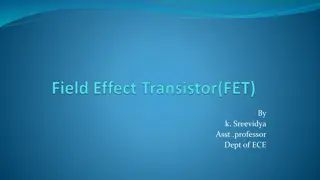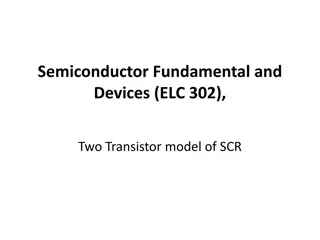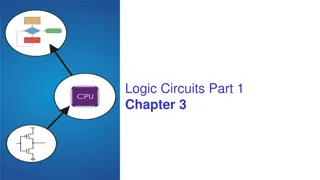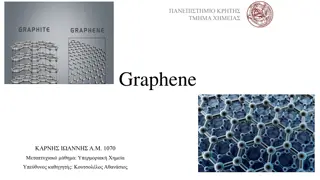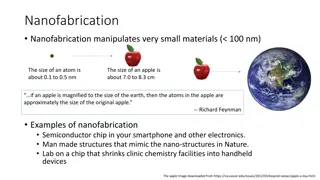Revolutionizing Electronics with Graphene-Based Transistors: A Game-Changer in Semiconductor Industry
Graphene, a single atom thick layer of carbon, holds immense potential in transforming the semiconductor industry. With exceptional properties such as high electron mobility, thermal and electrical conductivity, and strength, graphene offers a promising solution to the limitations faced by silicon transistors. Despite the challenge of zero bandgap in graphene, innovative approaches like bilayer graphene have been explored to overcome this obstacle. The development of graphene-based transistors could pave the way for enhanced performance, lower energy consumption, and increased efficiency in electronic devices.
Download Presentation

Please find below an Image/Link to download the presentation.
The content on the website is provided AS IS for your information and personal use only. It may not be sold, licensed, or shared on other websites without obtaining consent from the author.If you encounter any issues during the download, it is possible that the publisher has removed the file from their server.
You are allowed to download the files provided on this website for personal or commercial use, subject to the condition that they are used lawfully. All files are the property of their respective owners.
The content on the website is provided AS IS for your information and personal use only. It may not be sold, licensed, or shared on other websites without obtaining consent from the author.
E N D
Presentation Transcript
Graphene Based Transistors-Theory and Operation; Development State Alex Van Eck EE4611 04/12/17
Overview Moore s Law Properties of Graphene Band Gap Graphene Nanoribbons Future of Graphene
Introduction Major milestone in electronics was the discovery of the transistor in 1948 by physicists at Bell Labs Moore s Law Speed of integration is decreasing Stability gets poorer at sizes below 10nm Graphene could replace silicon to help this issue
Moores Law at an end? Putting more transistors on a chip keeps getting more and more difficult : shortening the distance between conductive channels greatly increases the possibility of current leakage/ heat Getting to the point where there is little room to improve Intel: working on 10nm chips Solve using graphene?
Graphene 1 Atom Thick Layer of carbon (2-Dimensional) Honeycomb Lattice Best Thermal Conductor Best Electrical Conductor Strongest Thinnest Material Known To Exist Electron mobility 250,000cm^2/Vs ~200 times greater than silicon Lower heat production and energy consumption International Journal of Advanced Research in Computer and Communication Engineering Vol. 1, Issue 4, June 2012
Graphene vs Silicon High mobility at room temperature Symmetric properties for holes and electrons Thickness One issue: zero energy gap
Bandgap Graphene s main problem for use in Semiconductor industry is having zero bandgap Bandgap allows movement of electrons from the valence to conduction bands in order for the material to switch currents on and off In graphene (1 atom thick) valence and conduction bands meet No bandgap= can not stop current flow Bilayer Graphene Graphene Nanoribbon http://electronics360.globalspec.com/article/7655/is-graphene-finally-a-replacement-for-silicon
Bilayer Graphene Lamination of two layers of graphene Zero bandgap, but apply an external electric field across the bilayer graphene to open the bandgap Bandgap is tunable by the applied electric field strength Bandgap has been tuned up to .3eV Widening of the Bandgap has also been confirmed
Graphene Nanoribbons Grown Chemically Synthesize rings of carbon atoms similar in structure to benzene Heating, under the right condition encourages them to bind together Heat again stripping most of the hydrogen atoms freeing carbon to form the honeycomb structure of graphene This process allows control over where each atom of carbon goes into the final ribbon Could potentially increase the density of transistors on a chip as much as 10000x Human Hair is 10,000 times wider than nanoribbon https://www.extremetech.com/extreme/176676-graphene-nanoribbons-could-be-the-savior-of-moores-law
Decrease the width of the graphene sheet Graphene is called a nanoribbon when the width is several times the unit cell of graphene Graphene nanoribbons exhibit semiconductor or metallic properties: bandgap is larger than 0 depending on how the nanoribbon is structured Armchair configuration exhibits semiconductor properties http://data.nistep.go.jp/dspace/bitstream/11035/2848/1/NISTEP-STT037E-76.pdf
Graphene Transistor Graphene exhibits a pronounced effect to perpendiciular external electric fields, which allows us to use it to build FETs The graphene transistors show very poor on-off ratios- small voltage gain, but operating frequencies are greater than 25GHz Researchers have been able to create transistors with an on-off ratio of 100GHz IBM developed 10k top gated transistors on a .24cm square chip
GFET MOSFET-most commonly used Si based device Electron and hole mobilities In GFETs are almost equal, making the transfer characteristics symmetric Operation reported higher than Si based FETS IEEE TRANSACTIONS ON ELECTRON DEVICES, VOL. 62, NO. 10, OCTOBER 2015
Advantages High Frequency Operation Work without much noise Self cooling Operate with little voltage Consume little power Wide temp range Great conductor
Disadvantages Difficult to turn off Single sheet of graphene is hard to produce Small voltage gain Hard to create on large scale
Most Likely/Future Applications Replace traditional Semiconductors in RF applications Touch Screens Rollable e-paper Foldable OLED Flexable, thin transistors
Conclusion Graphene transistors could make smaller, faster electronic chips that are achievable with Si Time will only tell if we can make the use of graphene in semiconductors a reality
References Abe Michelen. Is Graphene Finally A Replacement for Silicon? Consumer Electronics. 11 Novermber 2016. <http://electronics360.globalspec.com/article/7655/is-graphene-finally- a-replacement-for-silicon> Enhanced performance of graphene transistor with ion-gel top gate , Carbon 2014 Javad Bavaghar Chahardeh. A Review on Graphene Transistors International Journal of Advanced Research in Computer and Communication Engineering Vol. 1, Issue 4, June 2012 Max Lemme. Potential Applications for Graphene Devices in Nanoelectronics 2012 Yashushi Iyechikca, Application of Graphene to High-Speed Transistors: Expectations and Challenges Science and Technology Trends Quarterly Review No.37 October 2010
Topics Issue with using graphene in a transistor? No band gap Ways to fix the band gap problem with graphene? Nanoribbons, Bilayer graphene How does one induce a bandgap in bilayer graphene? Apply an electric field Pros and Cons of using graphene in transistors Advantages of Graphene vs Silicon




